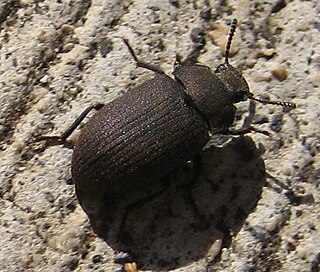
Darkling beetle is the common name for members of the beetle family Tenebrionidae, comprising over 20,000 species in a cosmopolitan distribution.

Tenebrioninae is the largest subfamily of the darkling beetles (Tenebrionidae), containing flour beetles, among others. Tenebrioninae contains more than 20 tribes.

Opatrini is a tribe of darkling beetles (Tenebrionidae) in the subfamily Tenebrioninae.
Kershawia is a genus of long-jointed beetles in the family Tenebrionidae. There is one described species in Kershawia, K. rugiceps, found in Australia.

Alleculinae is a subfamily of comb-clawed beetles belonging to the family Tenebrionidae. These beetles are characterized by an oval body, threadlike antennae, relatively long legs and tarsi quite elongated. Their most striking feature, however, are the combed claws of the hind tarsi, that show fine teeth.

The Sepidiini is a tribe of ground-dwelling darkling beetles (Tenebrionidae), that occurs across Africa, the Mediterranean Basin, the Arabian Peninsula and Mesopotamia. It is composed of many hundreds of species. The larvae of some species are known to damage crops.

Pimeliinae is a subfamily of beetles in the family Tenebrionidae.

Diaperinae is a subfamily of darkling beetles in the family Tenebrionidae. There are more than 120 genera in Diaperinae, grouped into 11 tribes.

Ulomini is a tribe of darkling beetles in the family Tenebrionidae. There are more than 20 genera among Ulomini.

Alphitobius is a genus of darkling beetles in the family Tenebrionidae. There are about 18 described species in Alphitobius.

Lagriinae is a subfamily of long-jointed beetles in the family Tenebrionidae. There are more than 270 genera in Lagriinae, grouped into 11 tribes.

Coelocnemis is a genus of darkling beetles in the family Tenebrionidae. There are about seven described species in Coelocnemis, found mainly in western Canada, western United States, and Mexico.

Blaptinae is a subfamily of darkling beetles in the family Tenebrionidae. There are around 300 genera in Blaptinae, divided into 7 tribes.

Akidini is a tribe of darkling beetles in the subfamily Pimeliinae in the family Tenebrionidae. There are about 5 genera in the tribe Akidini, species of which are found in the Palearctic.

Erodiini is a tribe of darkling beetles in the subfamily Pimeliinae of the family Tenebrionidae. There are more than 30 genera in Erodiini.
Cnemodinus is a genus of darkling beetles in the family Tenebrionidae. There are at least three described species in Cnemodinus. It is the only genus in the monotypic tribe Cnemodinini.
Nyctoporis is a genus of darkling beetles in the family Tenebrionidae. There are about five described species in Nyctoporis, found in North America.
Phrynocarenum is a genus of darkling beetles in the family Tenebrionidae, found in the Neotropics.

Metaclisa is a genus of darkling beetles in the family Tenebrionidae, the sole genus of the tribe Metaclisini. There are at least four described species in Metaclisa, found in North America, the Neotropics, the Palearctic, and Indomalaya.
Itagonia is a genus of beetles in the family Tenebrionidae. The majority of species are found in Southwest China, but two are found in the more central and northern parts of the country, from Gansu to Hebei and Inner Mongolia. They are relatively small and robust-bodied beetles.














